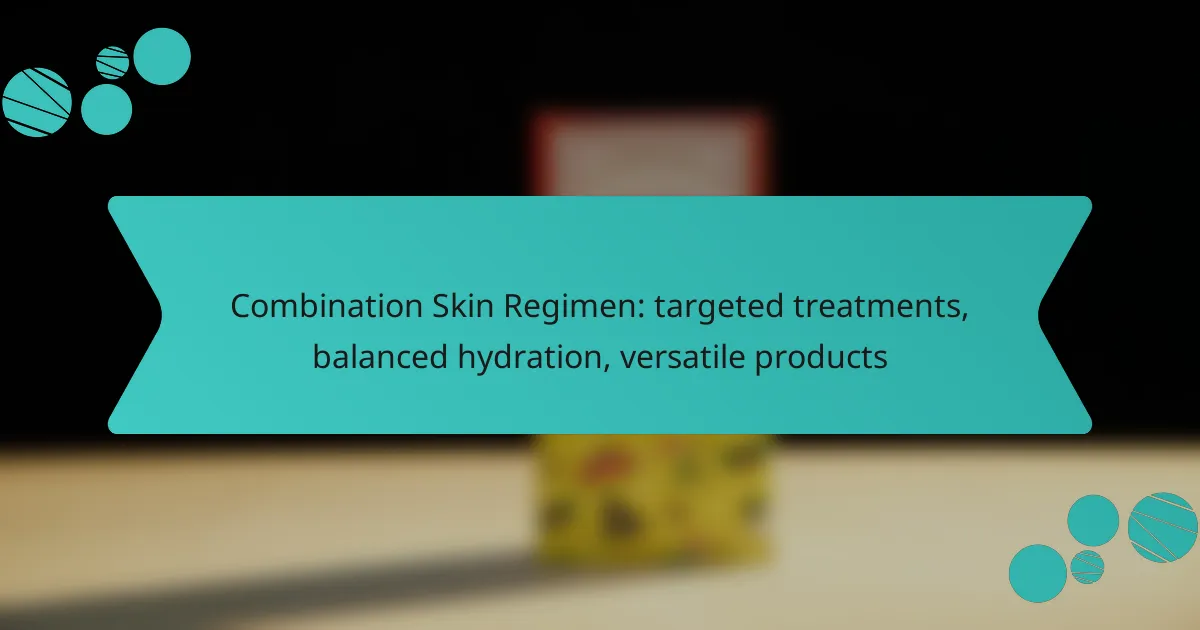Creating a skincare regimen for combination skin requires a careful balance of targeted treatments and hydration. Look for versatile products that cater to both oily and dry areas, ensuring your skin remains healthy and nourished throughout the day. By addressing specific concerns like blemishes and dry patches, you can achieve a harmonious complexion that thrives on balance.

What are the best products for combination skin in the UK?
The best products for combination skin in the UK balance hydration and oil control. Look for formulations that cater to both dry and oily areas of the face, ensuring that your skin remains healthy and well-nourished.
Hydrating serums
Hydrating serums are essential for combination skin, as they provide moisture without adding excess oil. Look for serums containing hyaluronic acid or glycerin, which attract and retain water in the skin.
Apply a hydrating serum after cleansing and before moisturizing to enhance hydration levels. Consider products that are lightweight and absorb quickly to avoid a greasy feel.
Lightweight moisturizers
Lightweight moisturizers are ideal for combination skin, as they hydrate without clogging pores. Choose gel-based or oil-free creams that provide moisture without heaviness.
Ingredients like aloe vera and jojoba oil can help balance oil production while keeping dry areas hydrated. Apply your moisturizer twice daily for optimal results.
Balancing toners
Balancing toners help to refine pores and control oil in combination skin. Look for alcohol-free formulas that include witch hazel or rose water, which can soothe and hydrate the skin.
Use a toner after cleansing to prepare your skin for serums and moisturizers. This step can enhance the overall effectiveness of your skincare routine.
Oil-free sunscreens
Oil-free sunscreens are crucial for protecting combination skin from UV damage without adding excess oil. Choose broad-spectrum SPF products that are labeled as non-comedogenic.
Apply sunscreen daily, even on cloudy days, to prevent sun damage. Look for lightweight formulas that absorb quickly and leave a matte finish.
Exfoliating cleansers
Exfoliating cleansers help remove dead skin cells and excess oil, making them beneficial for combination skin. Opt for gentle exfoliants containing salicylic acid or alpha hydroxy acids (AHAs).
Use these cleansers 2-3 times a week to maintain a smooth complexion without over-drying. Be cautious not to over-exfoliate, as this can lead to irritation and imbalance.

How to create a balanced skincare routine for combination skin?
To create a balanced skincare routine for combination skin, focus on targeted treatments that address both oily and dry areas while ensuring overall hydration. This involves using versatile products that can adapt to the varying needs of your skin throughout the day.
Morning routine steps
Start your morning routine with a gentle cleanser to remove overnight impurities without stripping moisture. Follow this with a lightweight, hydrating toner to balance your skin’s pH and prepare it for subsequent products.
Next, apply a targeted serum that addresses specific concerns, such as oiliness in the T-zone or dryness in other areas. Finish with a broad-spectrum sunscreen to protect your skin from UV damage, ensuring it is suitable for all skin types.
Evening routine steps
Your evening routine should begin with a thorough makeup remover or cleansing oil to ensure all makeup and dirt are removed. Follow up with a gentle cleanser to maintain skin clarity without over-drying.
Incorporate a nourishing moisturizer that provides hydration to dry areas while being lightweight enough for oilier zones. Consider adding a targeted treatment, like a retinol or exfoliating product, a few times a week to promote cell turnover and address specific skin concerns.
Weekly treatments
Weekly treatments can enhance your skincare routine by addressing specific issues more intensively. Use a clay mask on oily areas to absorb excess oil and unclog pores, while applying a hydrating mask on drier areas to boost moisture levels.
Exfoliation is also key; aim for a gentle chemical exfoliant once a week to remove dead skin cells without irritating sensitive areas. This helps maintain a balanced complexion and promotes a smoother skin texture.

What targeted treatments are effective for combination skin?
Effective targeted treatments for combination skin balance the needs of both oily and dry areas. Utilizing specific products can help address blemishes, hydrate dry patches, and exfoliate oily zones without disrupting overall skin health.
Spot treatments for blemishes
Spot treatments are essential for managing blemishes on combination skin. Look for products containing salicylic acid or benzoyl peroxide, which can effectively reduce inflammation and clear clogged pores. Apply these treatments directly to blemishes, avoiding surrounding areas to prevent excessive dryness.
When selecting a spot treatment, consider formulations that are lightweight and non-comedogenic to prevent further breakouts. Use them sparingly, typically one to two times daily, to avoid irritation.
Hydrating masks for dry areas
Hydrating masks can restore moisture to the dry areas of combination skin. Ingredients like hyaluronic acid, glycerin, and aloe vera are excellent for providing deep hydration without feeling heavy. Apply these masks once or twice a week, focusing on the drier parts of your face.
For optimal results, leave the mask on for the recommended time, usually around 10-20 minutes, and follow up with a light moisturizer to lock in hydration. Avoid masks with heavy oils or fragrances that may exacerbate oiliness in other areas.
Exfoliating treatments for oily zones
Exfoliating treatments help to manage excess oil and prevent clogged pores in oily zones. Look for products containing alpha-hydroxy acids (AHAs) or beta-hydroxy acids (BHAs), which can effectively slough off dead skin cells and promote cell turnover. Use these treatments 1-3 times a week, depending on your skin’s tolerance.
Be cautious not to over-exfoliate, as this can lead to irritation and increased oil production. Always follow up with a gentle moisturizer to maintain balance across your skin.

What are the common mistakes to avoid with combination skin?
Common mistakes with combination skin include over-exfoliating, using heavy creams, and neglecting hydration. These errors can exacerbate issues like dryness and oiliness, disrupting the skin’s balance.
Over-exfoliating
Over-exfoliating can strip the skin of its natural oils, leading to increased oil production in some areas and further dryness in others. It’s best to limit exfoliation to once or twice a week, using gentle products that suit your skin type.
Look for exfoliants that contain mild acids, such as lactic or salicylic acid, which can effectively remove dead skin without causing irritation. Avoid harsh scrubs that can damage the skin barrier.
Using heavy creams
Heavy creams can clog pores in oily areas while failing to provide adequate moisture to dry patches. Instead, opt for lightweight, non-comedogenic moisturizers that hydrate without overwhelming the skin.
Gel-based or oil-free formulas are often ideal for combination skin, as they provide hydration without the heaviness of traditional creams. Always check product labels for terms like “lightweight” or “non-greasy.”
Neglecting hydration
Neglecting hydration can lead to an imbalance, worsening both dry and oily areas. Hydration is essential for maintaining skin elasticity and overall health, so incorporate a hydrating serum or toner into your routine.
Choose products with hyaluronic acid or glycerin, which attract moisture to the skin. Aim to apply these hydrating products both morning and night for optimal results.

How to choose the right products for combination skin?
Selecting the right products for combination skin involves understanding its unique characteristics and needs. Look for formulations that balance hydration without overwhelming oily areas or drying out dry patches.
Identifying skin type
To effectively identify combination skin, observe how your skin behaves in different areas. Typically, the T-zone (forehead, nose, and chin) may be oily, while the cheeks and other areas can be dry or normal. This duality requires tailored products that address both concerns.
A simple test is to cleanse your face and wait for a few hours. If your forehead and nose become shiny while your cheeks feel tight, you likely have combination skin. Understanding this will guide your product choices.
Reading ingredient labels
When reading ingredient labels, prioritize lightweight, non-comedogenic products that hydrate without clogging pores. Look for ingredients like hyaluronic acid for hydration and salicylic acid to manage oiliness.
Avoid heavy oils and alcohols that can exacerbate dryness or oiliness. Instead, opt for formulations that contain a balance of humectants and emollients, ensuring both hydration and moisture retention across your skin’s varying zones.
